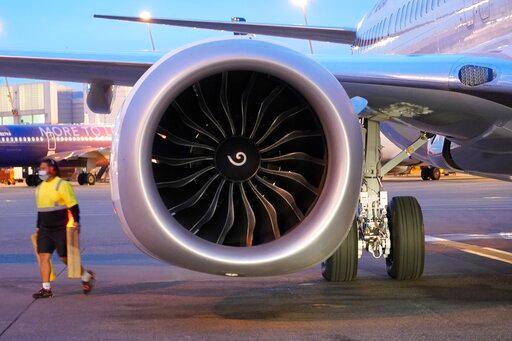
A ramp worker walks near a CFM International LEAP-1B engine on a Boeing 737-9 Max airplane Monday, March 1, 2021, at Seattle-Tacoma International Airport in Seattle. Photo by Ted S. Warren/AP Photo.
Ann Skeet (@leaderethics) is the senior director of leadership ethics at the Markkula Center for Applied Ethics. Views are her own.
This article was originally published in MarketWatch on July 25, 2024.
It is becoming easier to find corporate bad actors and draw a line from some companies’ choices to the harms they have caused for customers — and shareholders.
Boeing is only the most recent example. The aerospace giant was once respected for its airline safety and engineering prowess, as well as a solid reputation for building quality products and its ethical decision-making.
Now Boeing is tainted by its epic failure leading to customers’ injuries and deaths. The company has faced a series of engineering and quality failures, including two crashes of its 737 Max airplanes resulting in the deaths of 346 passengers. On Wednesday, Boeing agreed to plead guilty to a federal fraud charge — a felony — for misleading U.S. regulators about the 737 Max. The settlement with the U.S. Justice Department reportedly will subject Boeing to an independent compliance monitor, three years of probation and a $243.6 million fine, on top of billions of dollars in additional fines and legal costs it is being forced to pay.
Who pays for this? Shareholders do. Boeing’s stock is down 31% this year through July 24. While the most grievously injured victims are often a company’s customers, the shareholders are also harmed, though in their case the damages are felt financially.
Families of victims have received huge financial settlements from Boeing, though some of those settlements are being challenged as insufficient. In addition to payouts to victims, companies found guilty of missteps that harm customers receive significant fines — particularly if their ethics and compliance efforts are found lacking, as is the case with Boeing.
Boeing traded in long-term strategies valuing operational excellence and customer safety in exchange for short-term profits. What can investors look for to spot the drift from such successful strategies, to those that favor profits over ethical decision-making?
A key step in a framework for ethical decision-making is to identify those individuals and groups that have an important stake in a decision’s outcome.
Our research has shown there are three conditions that support the use of ethics in organizations. Learning to spot their presence, or absence, can guide shareholders in identifying organizations less likely to act in ways that create harm to customers or other forms of reputational risk.
- Does the company have a climate of mutual trust and understanding? Does a firm set of values guide decision-making in such a way that decisions are able to be decentralized? Do people feel comfortable speaking up and bringing issues forward? In Boeing’s case, whistleblowers have come forward and made clear that employees did not feel they could speak frankly about safety concerns.
- Does the company use ethical deliberation practices? Are decisions based on facts, include stakeholders and consider a decision’s downstream effects? Once decisions are made, is the thinking behind them shared openly?
- Does the company have a sense of responsibility to society? Do you see in their actions and their partnerships a commitment to community and the environment and a sense that the company is in turn impacted by society? This is fundamental corporate citizenship.
Admittedly, some aspects of these conditions are difficult to assess from outside the company. But there are signs that investors can look for to have a higher level of confidence:
1. The company’s leadership should espouse a commitment to accountability, not only at the corporate level but individually. This might be articulated in the corporation’s values, or in high-profile instances of holding executives accountable for errors on their watch.
At times, the absence of accountability is actually easier to spot and might only become evident after the fact. Some companies, including Johnson & Johnson, have deployed a maneuver known as the “Texas Two-Step” for avoiding the penalties that come from their mistakes. This tactic involves splitting a company into two entities and loading one with all the liabilities resulting from the errors and then having that new entity file for bankruptcy, thus protecting the remaining assets from future claims of harm and wrongdoing. In this way, the corporation avoids responsibility.
Individuals can skirt accountability as well. Boeing Chief Executive David Calhoun is staying in his job through year-end, when he will receive a golden parachute. Neither outcome seems fair in light of the price that has been paid by Boeing’s customers and investors.
2. Is the board interested in the ethical culture of the company? Adjustments made to U.S. federal sentencing guidelines in 2013 allow for the reduction of fines for ethical missteps if a company can demonstrate that there has been an attempt to know and assess the company’s culture. Organizations that take this seriously are engaged in regular ethical-culture self-assessment and are responsive to the findings of those assessments.
Companies can be held accountable when they have knowingly cut corners for customer safety. Investors can become better educated about how to spot companies headed for reputational trouble by learning about what using ethics actually looks like inside of corporate America. It’s one way customers and investors can protect themselves from corporate wrongdoing.